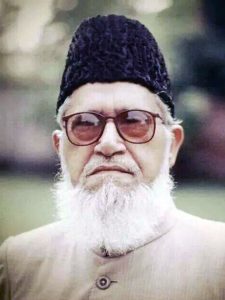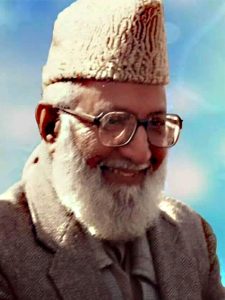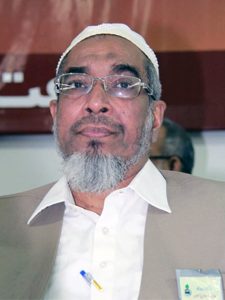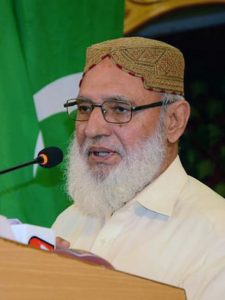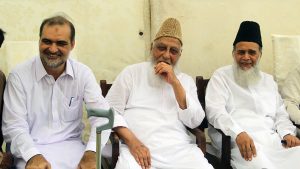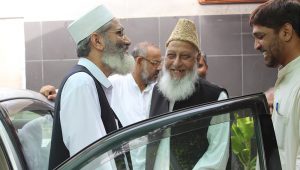THE LIVES LOST – FOR NOTHING
The Muhajir Qaumi Movement (MQM) held a public meeting on August 8, 1986, at the Nishtar Park, wherein Altaf Hussain delivered an extremely provocative speech with an aim to incite hatred of other races among the Urdu-speaking residents of urban Sindh. The highlight of the meeting was the display of modern weapons on the stage by the young members of the party. A few weeks after the gathering, law enforcement agencies carried out a so-called operation at Sohrab Goth against encroachers and drug peddlers, and just two days later, mysterious terrorists armed with sophisticated weapons launched a violent attack on Qasba and Aligarh Colony. The people of Karachi had never thought of such a terrorist act. A widespread bloodshed ensued, resulting in the deaths of dozens of innocent people. What followed was a deliberately spread rumor that Pathans attacked Muhajirs and killed more than 400 people.
Soon, fear gripped the city. Groups of angry youth took to the streets, and the reaction began. No one was willing to understand that people belonging to the communities are scattered in the city and they have been living with each other in different neighborhoods for years. So if it was a Pathan-Muhajir fight, why did the act of grave violence occur in just one neighborhood? Jamaat-e-Islami (JI) office-bearers and workers initiated a recovery campaign for the victims. They provided ration to the people, helped in the burial of the deceased, and arranged for moving the injured to the hospitals. The members of JI’s women wing also fully participated in the relief activities. Altaf Hussain and his comrades based their politics on this tragedy and the dead, and it was what they were always recognized with. They created much fuss about why the commissioner, who had the police under his command, didn’t do anything to protect lives and properties. They several times claimed that they had the videos of the attackers and several could be identified. However, none were ever produced in a court.
یہ خونِ خاک نشیناں تھا، رزقِ خاک ہوا
In those days, the Karachi Municipality wasn’t financially strong, and Mayor Abdul Sattar Afghani had pointed out to the provincial government the need to increase the developmental budget and give the city its due share from the motor-vehicle tax collected from the metropolis. The Sindh government wasn’t ready to pay heed to any such demands. Annoyed at their indifference, the mayor, accompanied by his councilors, took out a rally at the MA Jinnah road on Feb 12, 1987. The chief minister dissolved the elected municipality and sent the elected representatives of the city behind bars. The mayor was among those arrested. Subsequently, senior bureaucrat Saeed Siddiqui was made the administrator of the new municipality. The local bodies’ elections were held on Nov 30, 1987. Believing in Altaf Hussain’s slogans and promises of delivering rights, people of Karachi and Hyderabad voted his candidates to a historic victory. JI’s mayors were elected in 1979 and then in 1983, but both the times, the deputy mayor belonged to another party. This time, when Dr. Farooq Sattar (Karachi) and Aftab Sheikh (Hyderabad) were elected as mayors, the deputy mayors were also from the same group. Even Altaf Hussain and his close aides hadn’t anticipated such an overwhelming win.
In 1987, Mian Tufail Muhammad recused himself from JI’s chairmanship, and the members elected Qazi Hussain Ahmad as the new chief of the party in October that year. Qazi Sahib had previously served the party as secretary general. He once told me that if the eastern arm of the country hadn’t split, Prof. Ghulam Azam would have been elected as the markazi ameer (central chief) who, in his opinion, was the best man for the job. Qazi Sahib had great liking and reverence for the leaders of JI Bangladesh, and he would weep when speaking about them. On May 29, 1988, General Zia-ul-Haq invoked the Constitution’s Article 58-2B to dismiss the government and announced to dissolve the assemblies. Prime Minister Muhammad Khan Junejo and his team were sent home. As an MPA, I used to receive a monthly remuneration of Rs6,000 in my bank account. When my term came to an end, I transferred the entire amount to JI’s Bait-ul-Maal (treasury).
On Aug 17, 1988, President Zia-ul-Haq and high-ranking military officers were killed in an air accident near Bahawalpur. He had several qualities in him. He had the opportunity to rule for a long period of time with full powers. He gave Dr. Abdul Qadeer Khan and Ghulam Ishaq Khan a free hand to work so that Pakistan could be turned into an atomic power, and successfully kept the critical project safe from all sorts of intervention. But, like other dictators, he made every bit to weaken the political and democratic forces and ‘grew’ new and favorable politicians in the ‘nursery’ of establishment. To rival the PPP, he allowed leeway to MQM to enable the party to find a footing and spread in the urban areas of Sindh. It was during his term that students’ unions were banned, and the country was thrown into the fire of sectarian, linguistic, and racist hatred. He followed the philosophy of divide and rule. Whether or not it was deliberate is up to the time to decide.
How could educational institutions remain safe from Altaf Hussain’s politics of torture and his style of politics? Their students’ wing was now turning into a mafia, and even the MQM leaders couldn’t realize that the politics of violence would be harmful even for themselves, and they would turn on each other. On August 30, 1988, Aamir Saeed, a member of Islami Jamiat-e-Talaba (IJT) and a student of Government National College, was abducted by AMPSO hooligans, and he was found dead a few hours later. He was subjected to extreme torture and then shot with multiple bullets. Unfortunately, this wasn’t the last martyrdom of an IJT or JI member at the hands of Altaf’s mafia. In the later days, Altaf Hussain turned into an idol who would need a sacrifice every day.
Karachi commissioner Syed Sardar Ahmad was later made an MPA and senior minister of Altaf Hussain’s party. The party that enjoyed the perks of the federal and provincial ministries in the next several regimes took no practical interest in the investigation of Qasba-Aligarh tragedy, and not one accused was arrested or punished. Today’s generation should think about who benefited from the tragedy and who gained overnight political fame. Which organization’s members continued to be in the federal and provincial cabinets for decades? In the elections of 1988 and 1990, most MQM candidates didn’t face much opposition as expected. Altaf Hussain was so popular that a politician of Prof. Ghafoor Ahmad’s stature lost to an unknown man, Kanwar Khaild Younus. Syed Munawar Hassan and Maulana Shah Ahmad Noorani, too, were met with heavy defeats by candidates who no one knew. JI was part of Islami Jamhoori Ittehad in both the elections. MQM joined the PPP government in 1988 and then Nawaz Sharif’s in 1990. The promises since the 80s of abrogating the quota system and repatriating refugees from Bangladesh’s camps were never spoken about by the representatives of Karachi and Hyderabad.
Dr. Farooq Sattar, soon after becoming a mayor, set the precedent of destroying merit by employing the party’s office-bearers and workers in government institutions. This tradition was cemented further after they obtained federal and provincial ministries. In Sindh, it became impossible for a common man to secure employment in any government department. These jobs were reserved for the high-ups, relatives, and workers of the PPP and Altaf Hussain’s party. The government institutions turned into the offices of these political parties in no time. The government-run schools were the only source of support for the middle class and the destitute segments of society to progress. The aforementioned degradation of educational institutions deprived children of free-of-cost quality education, and youth were handed weapons. The public sector hospitals narrated the same tale. Meanwhile, there was a steep rise in the number of private schools, coaching centers, and private hospitals. In the first week of December 1990, I was appointed the ameer (chief) of JI district central. Earlier, Mateen Ali Khan served as the district chief, with Syed Hafeezullah (secretary) and Dr. Meraj-ul-Huda as part of his team as naib (deputies). I nominated Dr. Meraj-ul-Huda Siddiqui as my qayyim (secretary) and Hafeezullah Sahib and Iftikhar Ahmad Sahib as deputies. Dr. Meraj had earlier served as the nazim of IJT’s Karachi chapter, and after his duties in IJT, Mateen Ali Khan sahib included him in his team and tasked him with the Usman Public School project, which was in its initial phase at the time.
Altaf Hussain and his aides were badly affected by their limitless popularity and power, causing them to develop differences within. JI had decided from day one to face the storm with patience and resilience, all the while focusing on its work of dawah and winning the hearts of the masses through public welfare. Qazi Hussain Ahmad appointed me the ameer of JI Karachi on February 2, 1991, while Syed Munawar Hassan was made markazi naib qayyim. In the same year, I took Rashid Nasim (qayyim), Abdul Rasheed Sahib, and Noor Muhammad Lakhani Sahib (naib ameer), Abdul Rasheed Baig, Shamim Ahmad, and Syed Muhammad Bilal (naib qayyim) under my team as Karachi ameer.
Former mayor Abdul Sattar Afghani used to oversee the public aid affairs. If some day, our vehicle wasn’t able to reach him, he would take a rickshaw or taxi to the office. A man who served as the mayor for eight years was unable to own a vehicle. At the time, Shahid Shamsi was the information secretary, while Usama Ismail Murad was Al-Khidmat Welfare Society’s secretary. In 1994, I made some changes and appointed Muhammed Hussain Mehanti as the secretary, Syed Hafeezullah (who was also serving as secretary Al-Khidmat), and Iftikhar Ahmad as naib ameers. Muazzam Ali Qadiri was assigned the post of naib qayyim. Former Karachi qayyim Syed Asif Ali was looking after the education wing of the party during my term. Al-Khidmat’s madaris (seminaries dedicated to Hifz and Nazirah – memorization and recitation of the Holy Quran) and Saudabad’s Jamia Hanifia, JI Karachi’s largest madrasa, were under his supervision. During 1993-96, due to the efforts of a young JI member, Syed Naeem Ahmad, this department was able to build six campuses of Hanifia Public School in Saudabad, Federal B. Area, and Orangi Town. Syed Asif Ali was a senior member of JI Karachi and a very pious man. JI’s first office in Karachi was established on his personal property. He would visit Jamia Hanifia daily and Idara noor-e-haq in the evening.
After becoming Karachi’s ameer, I could hardly find time for my family, let alone for my profession as a lawyer. My wife and daughters would sometimes softly complain about it, but I didn’t have a solution. My eldest son Wasim Iqbal was working in a private company after completing his engineering from NED University. Nadeem Iqbal did LLB and gradually took charge of the ‘Naimatullah & Co’ and successfully maintained the level of satisfaction of my years’ old clientele. None of my sons ever wished for a public-sector job as they knew very well that I would never send a referral for them to anyone. Fahim Iqbal and Nazim Iqbal went into a printing business, but they, too, were never allowed to get a printing job from JI or Al-Khidmat.
In 1991, Altaf Hussain’s ties with the establishment took a downward slope, and he had to flee the country overnight. When a military operation against his target killers began, JI adopted a balanced and democratic approach. We opposed the military operation at every forum because we believed that an operation against any political party isn’t the solution. Peace cannot be established and criminals can’t be curbed without basic reforms in the system of police and judiciary. No one in the city would dare lodge an FIR in any police station against the terrorists because of the potential threat, even if dozens were witnesses to the crime committed in broad daylight.
A separate faction was formed with the help of Altaf’s close aides, Afaq Ahmad and Aamir Khan. The city’s walls were inscribed with the slogan: ‘Quaid’s (chief’s) traitor deserves death,’ and members of both groups began to kill each other.
|
|
![]()
